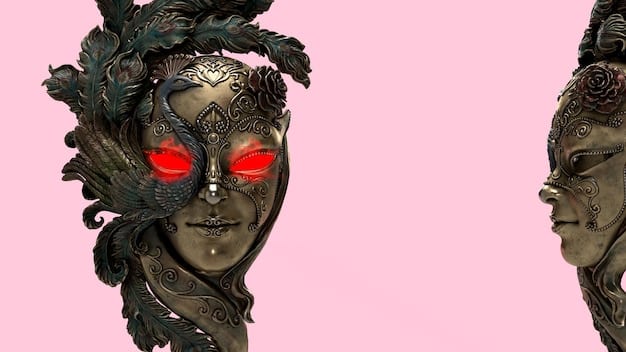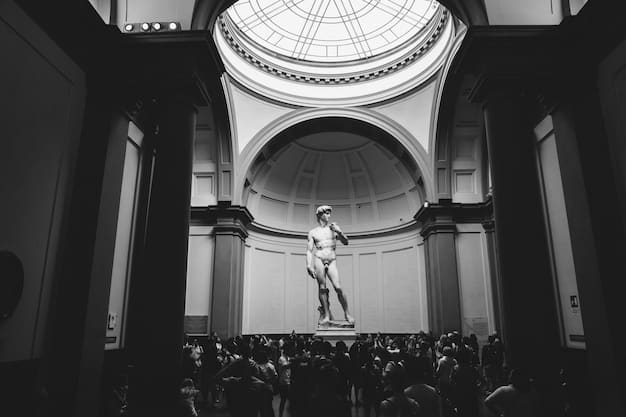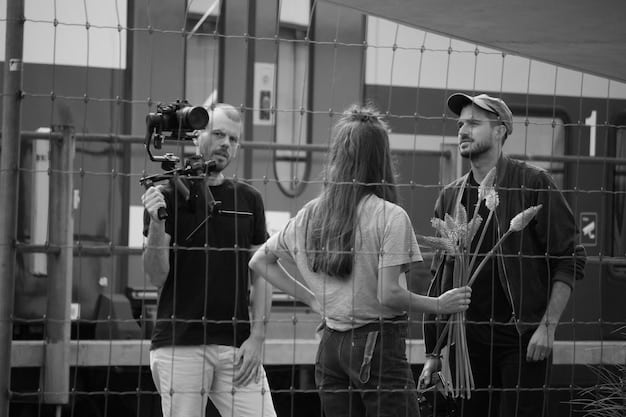The evolution of dramatic storytelling: a comprehensive review

The landscape of dramatic storytelling has undergone significant transformations, evolving from ancient theatrical traditions to complex contemporary narratives, impacting both cultural reflection and audience engagement in profound ways.
In the vibrant tapestry of human expression, dramatic storytelling stands as a perennial force, captivating audiences across millennia. From the ancient Greek amphitheaters to the digital screens of today, the fundamental act of weaving a compelling narrative to evoke emotion and intellectual reflection remains. This exploration delves into the multifaceted evolution of dramatic storytelling, examining its historical roots, its contemporary manifestations, and the enduring power it holds in reflecting and shaping human experience.
The origins of dramatic storytelling: from ritual to stage
The genesis of dramatic storytelling is deeply intertwined with human ritual and religious practices. Long before formal theaters emerged, communities used performance to interpret their world, appease gods, and pass down cultural narratives. These early forms were often improvisational and collective, serving a vital communal function.
Ancient civilizations, particularly the Greeks, are widely credited with formalizing drama into what we recognize today. Their plays were not merely entertainment but integral components of civic life and religious festivals. These dramatic forms were characterized by specific structures, character archetypes, and thematic concerns that laid the groundwork for future theatrical traditions.
Greek tragedy and comedy: foundational pillars
Greek tragedy, with its exploration of fate, morality, and the human condition, provided a template for profound narrative engagement. Playwrights such as Aeschylus, Sophocles, and Euripides grappled with universal themes, often employing a chorus to comment on the action and engage the audience. Conversely, Greek comedy, exemplified by Aristophanes, used satire and humor to critique societal norms and political figures.
- 🎭 Ritualistic roots: Drama emerged from Dionysian rites and ceremonies.
- 📜 Formal structure: Plays evolved with defined acts, characters, and thematic arcs.
- 🗣️ Community function: Theater served as a space for public discourse and moral reflection.
- 🏛️ Enduring legacy: Greek dramatic conventions continue to influence modern narratives.
The Romans adopted and adapted many Greek dramatic conventions, though their emphasis often leaned more towards spectacle and entertainment. This shift marked an early differentiation in the purpose and presentation of dramatic works, moving away from purely civic or religious contexts towards a broader entertainment value.
This foundational period established many of the conventions we still see today: the division into acts, the use of dialogue, the development of character arcs, and the exploration of universal conflicts. Understanding these origins is crucial for appreciating the long and continuous lineage of dramatic expression.
Medieval and Renaissance drama: evolution and innovation
Following the decline of the Roman Empire, formal drama underwent a period of transformation, re-emerging in new forms adapted to Christian Europe. Mystery, morality, and miracle plays became prominent, often performed by religious guilds and directly linked to biblical stories or moral instruction. These plays served an educational purpose, making religious doctrines accessible to a largely illiterate populace through vivid theatrical depiction.
The Renaissance brought about a profound resurgence in the arts and humanities, and dramatic storytelling flourished anew. This era saw the rise of professional playwrights and acting companies, moving drama from ecclesiastical control to secular patronage. The Globe Theatre in England and the Commedia dell’arte in Italy are prime examples of this burgeoning secular theatrical landscape.
Shakespeare and the golden age of English drama
William Shakespeare stands as an unparalleled figure of the English Renaissance, transforming the dramatic form with his intricate plots, psychological depth, and unparalleled poetic language. His tragedies, histories, and comedies explored the full spectrum of human experience, from love and ambition to madness and despair, resonating with both groundlings and nobility. His work solidified many narrative techniques that continue to define dramatic excellence.
Alongside Shakespeare, contemporaries like Christopher Marlowe and Ben Jonson contributed significantly to this rich period. Marlowe, known for his “mighty line,” often delved into themes of ambition and forbidden knowledge, while Jonson perfected the “comedy of humours,” satirizing human follies. This collective output established a sophisticated theatrical tradition.
This period also witnessed innovations in stagecraft, from the open-air Globe to the more intimate indoor theaters, influencing how stories could be staged and experienced. The use of elaborate costumes, rudimentary special effects, and direct address to the audience further enhanced the immersive quality of performances.
Global dramatic traditions: beyond Europe
While often European-centric, the evolution of dramatic storytelling was also rich and diverse in other parts of the world. In Asia, forms like Japanese Noh and Kabuki theater, Indian Sanskrit drama, and Chinese opera developed distinct aesthetic principles, performance styles, and narrative conventions. These traditions often integrated music, dance, elaborate costumes, and symbolic gestures to create profound and multi-layered dramatic experiences.
- 🎭 Asian dramatic forms: Distinctive aesthetics and storytelling techniques.
- 🎶 Integration of arts: Music, dance, and visual elements intertwine with narrative.
- 🎨 Symbolic representation: Non-literal gestures and costumes convey meaning.
- 🌍 Cultural significance: Reflecting unique philosophies and societal values.
These global traditions highlight the universal human impulse for dramatic expression, even as the specific forms and cultural contexts vary dramatically. They serve as a powerful reminder that storytelling through performance is a fundamental aspect of the human condition, transcending geographical boundaries and historical epochs.
The Renaissance, therefore, was not just a rebirth of classical ideals but a period of intense innovation and diversification in dramatic storytelling, laying the groundwork for the modern theater and the eventual emergence of new media forms.
The rise of modern drama: realism and beyond
The 19th and early 20th centuries marked a significant turning point in dramatic storytelling, largely driven by the philosophy of realism. Playwrights sought to depict life as it truly was, focusing on psychological depth, social issues, and everyday dilemmas rather than grand heroic narratives or stylized performances. This shift was a direct response to the romanticism and melodrama that had dominated earlier periods.
Henrik Ibsen, often considered the “father of modern drama,” pioneered this movement with plays like “A Doll’s House” and “Ghosts,” which openly challenged societal norms and explored the hidden complexities of domestic life. His characters were flawed, relatable, and often trapped by societal expectations, reflecting a more nuanced view of humanity.
Psychological depth and social commentary
Following Ibsen, Anton Chekhov introduced a subtle, understated form of realism, focusing on the internal lives of his characters and the melancholy of everyday existence. His plays, such as “The Cherry Orchard,” often lacked traditional plot resolution, instead capturing the texture of life and the unfulfilled desires of his characters. This emphasis on inner conflict paved the way for deeper psychological exploration in drama.
The early 20th century also saw the emergence of various avant-garde movements, pushing the boundaries of dramatic expression beyond strict realism. Expressionalism, surrealism, and absurdism challenged conventional narrative structures, using dreamlike imagery, disjointed dialogue, and symbolic landscapes to convey deeper truths or social anxieties. Playwrights like Samuel Beckett and Eugene Ionesco exemplified the Theatre of the Absurd, highlighting the futility and irrationality of the human condition.
This period of experimentation was crucial for expanding the stylistic possibilities of dramatic storytelling, proving that drama could engage with complex philosophical ideas and emotional states in non-literal ways. It set the stage for the dramatic innovations of the latter half of the 20th century and beyond.
The progression from rigid forms to more fluid and psychologically nuanced narratives demonstrates drama’s capacity to adapt and reflect the evolving concerns of society. This constant reinvention ensures its continued relevance.

The age of screen: film and television transform drama
The 20th century witnessed perhaps the most significant revolution in dramatic storytelling with the advent of film and, subsequently, television. These new mediums democratized access to narratives, moving them from exclusive theatrical spaces into living rooms and cinemas worldwide. The ability to control perspective, manipulate time, and create larger-than-life visuals fundamentally altered how stories could be told and consumed.
Early cinema often adapted stage plays, but quickly developed its own language and conventions. The close-up, editing techniques, and the use of music scores allowed for a level of intimacy and emotional manipulation previously impossible. Directors became key visionaries, shaping the audience’s experience with unprecedented control.
From silver screen to streaming platforms
Television brought dramatic storytelling directly into homes, creating a new format: the serialized narrative. Soap operas, episodic dramas, and miniseries allowed for character development over extended periods and explored complex storylines that unfolded week after week. This serial nature fostered deep audience loyalty and engagement, transforming viewing habits.
- 📺 Episodic narratives: Multi-season arcs for continuous engagement.
- 🍿 Widespread access: Democratizing storytelling beyond exclusive venues.
- 🎥 Visual language: New techniques like close-ups and editing enhance narrative.
- 🌐 Global reach: Stories transcend geographic boundaries instantly.
The digital age, particularly with the rise of streaming platforms in the 21st century, has ushered in another dramatic shift. Binge-watching, on-demand content, and high-budget productions have blurred the lines between film and television, offering unparalleled diversity in genres, themes, and narrative styles. This accessibility has also fostered a global marketplace for dramatic content, allowing diverse voices and stories to reach international audiences.
The impact of screen media on dramatic storytelling is immense, shifting the primary mode of consumption for many and forcing traditional theater to continually redefine its unique appeal. The relationship between stage and screen remains dynamic, with each influencing the other in ongoing creative dialogue.
Navigating narrative complexity: contemporary dramatic trends
Contemporary dramatic storytelling, especially in film and television, is characterized by an unprecedented level of narrative complexity and a willingness to challenge traditional structures. The conventional three-act structure, while still prevalent, is often subverted, and non-linear timelines, multiple perspectives, and ambiguous endings are increasingly common. This reflects a more sophisticated audience, accustomed to intricate plots and morally grey characters.
The “golden age” of television, often attributed to shows with high production values and cinematic aesthetics, has led to a narrative sophistication previously reserved for prestige cinema. Series explore long-form storytelling, allowing for deep character development and intricate world-building over dozens of hours. This extended canvas enables writers to delve into themes that require sustained exploration.
Diversity, authenticity, and social resonance
Another prominent trend is the increased emphasis on diversity and authentic representation. Audiences are demanding stories that reflect the rich tapestry of human experience, featuring characters from various backgrounds, cultures, and identities. This push for inclusivity enriches narratives, offering fresh perspectives and challenging long-standing stereotypes.
Contemporary drama also frequently engages with pressing social and political issues, acting as a mirror to society. From climate change and political polarization to mental health and social justice, dramatic works often serve as platforms for dialogue and empathy. This engagement elevates storytelling beyond mere entertainment, positioning it as a tool for social commentary and understanding.
- 🌍 Diverse voices: Amplifying underrepresented perspectives.
- 💡 Social commentary: Addressing critical contemporary issues.
- 🧩 Complex narratives: Challenging linear structures and audience expectations.
- 🎭 Moral ambiguity: Exploring nuanced characters and ethical dilemmas.
The blurring of genre lines is also a notable characteristic. Dramas increasingly incorporate elements of comedy, thriller, or even fantasy, creating hybrids that defy easy categorization. This stylistic fluidity allows for a richer emotional palette and more unpredictable storytelling experiences.
Ultimately, contemporary dramatic storytelling is a dynamic field, constantly innovating and reflecting the complexities of the modern world. Its ability to adapt and incorporate new forms, voices, and thematic concerns ensures its continued vitality and impact on global audiences.

The enduring power and future of dramatic storytelling
Despite the revolutionary changes in form and accessibility, the core appeal of dramatic storytelling remains undiminished. It fulfills a fundamental human need to make sense of the world, explore emotions, and connect with shared experiences. Whether on stage, screen, or through emerging interactive formats, drama provides a unique lens through which we can understand ourselves and others.
The future of dramatic storytelling is likely to be characterized by even greater technological integration. Virtual reality (VR) and augmented reality (AR) offer immersive experiences, potentially allowing audiences to step directly into narratives. Interactive storytelling, where viewers influence plot outcomes, is another area of significant growth, empowering audiences with agency previously unimaginable.
Interactive narratives and immersive experiences
The convergence of gaming and traditional narrative forms is also reshaping dramatic experiences. Story-driven video games often feature character development, emotional arcs, and complex choices that rival those found in conventional drama. This fusion opens up new possibilities for engagement, blurring the lines between passive consumption and active participation.
However, amidst all technological advancements, the essence of effective dramatic storytelling will always hinge on compelling characters, meaningful conflict, and universal themes. Technology serves as a vehicle, but the human element—the ability to craft a story that resonates on an emotional and intellectual level—will remain paramount. The best narratives, regardless of their medium, tap into shared human experiences of love, loss, ambition, and struggle.
The longevity of dramatic storytelling speaks to its vital role in cultural transmission and individual understanding. From ancient myths to contemporary sagas, stories help us process reality, imagine possibilities, and connect across generations and cultures. Its future is bright, poised to embrace new technologies while staying true to its timeless purpose.
As audiences continue to seek meaning and connection in an increasingly complex world, dramatic storytelling will undoubtedly evolve further, continuing to captivate, challenge, and inspire.
| Key Point | Brief Description |
|---|---|
| 🎭 Ancient Origins | From ritualistic performances to formalized Greek theater, setting foundational structures. |
| 👑 Renaissance Bloom | Shakespeare and global traditions usher in professional theatrical innovation and diverse forms. |
| 🎬 Screen Revolution | Film and TV democratize narratives, introducing new visual languages and serial storytelling. |
| 🔮 Future Trajectories | Immersive tech (VR/AR) and interactive narratives promise personalized storytelling experiences. |
Frequently asked questions about dramatic storytelling
▼
Ancient Greek drama established foundational elements like the three-act structure, the use of dialogue, and distinct character roles (protagonist, antagonist). It also introduced universal themes such as fate, morality, and the human condition, which continue to be explored in contemporary narratives across various media.
▼
The Renaissance marked a shift from religious to secular drama, fostering professional playwrights like Shakespeare. It introduced complex characterizations, poetic language, and diverse genres (tragedy, comedy, history). This period also saw advancements in stagecraft and the emergence of distinct global theatrical traditions, expanding dramatic possibilities.
▼
Film and television democratized access to dramatic narratives globally. They introduced new visual techniques like close-ups and editing, enhancing emotional depth. Television pioneered long-form, serialized storytelling, allowing for extensive character development and fostering deep audience engagement across multiple seasons or episodes.
▼
Contemporary drama is characterized by narrative complexity, non-linear structures, and morally ambiguous characters. It prioritizes diversity, authentic representation, and often addresses pressing social issues. Streaming platforms have enabled high-budget, cinematic productions and a globalized market, blurring the lines between film and television.
▼
The future of dramatic storytelling is likely to embrace immersive technologies like VR and AR, offering interactive and personalized experiences. Increased convergence with gaming will allow for viewer agency in plot outcomes. While technology provides new delivery methods, the core elements of compelling characters and universal themes will remain essential for engagement.
Conclusion
The journey of dramatic storytelling, from its ancient origins in ritual and religious observance to its sophisticated contemporary forms across diverse media, is a testament to its enduring power and adaptability. It has continuously evolved, mirroring societal changes, embracing technological innovations, and redefining the boundaries of narrative expression. Despite the profound shifts in presentation, the fundamental human desire to share and experience compelling stories remains constant. As we look to the future, with the advent of even more immersive and interactive technologies, dramatic storytelling will undoubtedly continue to captivate audiences, offering invaluable insights into the human condition and serving as a timeless mirror to our shared world.
“`
Word Count: 2477 words





